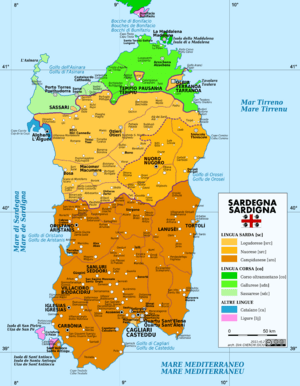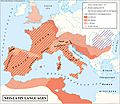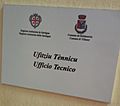Sardinian language facts for kids
Quick facts for kids Sardinian |
|
|---|---|
| Sardu | |
| Native to | Italy |
| Region | Sardinia |
| Ethnicity | Sardinians |
| Native speakers | (~1 million cited 1993-2007) |
| Language family | |
| Official status | |
| Official language in | Sardinia |
| Regulated by | Limba Sarda Comuna |
| Linguasphere | 51-AAA-s +(Corso-Sardinian) 51-AAA-pd & -pe |

Languages and dialects of Sardinia. Sardinian is spoken in all the orange-coloured areas.
|
|
Sardinian (called Sardu, Limba, or Lingua sarda by its speakers) is a Romance language. This means it comes from Latin, the language spoken by the ancient Romans. Sardinian is spoken mainly on the island of Sardinia. Sardinia is a large island in the Mediterranean Sea. It is also an area of Italy that has its own special rules.
Many people think Sardinian is the closest language to Latin. It has kept many old Latin sounds and words. For a long time, the Italian government did not officially recognize Sardinian. But now, it has more recognition.
Contents
What is the Sardinian Language?
Sardinian is a very old language. It developed from the Latin spoken by Roman soldiers and settlers. They came to Sardinia many centuries ago. Over time, this Latin changed into the Sardinian we know today.
The language is spoken by about one million people. Most of these speakers live on the island of Sardinia. It is an important part of the island's culture.
Where is Sardinian Spoken?
Sardinian is spoken across most of Sardinia. However, there are different ways of speaking it. These are called dialects. Some main dialects include Logudorese and Campidanese.
These dialects have small differences in how words are said. They also have some different words. But speakers of different dialects can usually understand each other.
Why is Sardinian Special?
Sardinian is special because it kept many features of old Latin. Other Romance languages changed more over time. This makes Sardinian a valuable language for studying how Latin evolved.
It also has words from other languages. These include words from Spanish and Catalan. This is because Sardinia was ruled by Spain for a long time.
Sardinian in Daily Life
Sardinian is used in many parts of daily life. People use it at home and with friends. You can also see it on signs and in local newspapers.
The language is taught in some schools on the island. There are also efforts to use it more in public. This helps keep the language alive for future generations.
Official Recognition
For many years, Italian was the main language in Sardinia. Sardinian was not officially recognized by the Italian government. This meant it was not used in schools or government offices.
However, things have changed. In 1997, Italy passed a law. This law recognized Sardinian as a minority language. This was a big step for the language.
Now, Sardinian has more support. There are programs to promote its use. This helps ensure that the language continues to thrive.
Sardinian Culture and History
The Sardinian language is deeply connected to the island's history. It tells the story of the Sardinian people. Their unique culture is reflected in their language.
Ancient texts and songs are written in Sardinian. These old writings help us learn about the past. They show how people lived and thought centuries ago.
Old Writings in Sardinian
Some of the oldest writings in Sardinian are called condaghes. These were legal documents from monasteries. They tell us about land and people in the Middle Ages.
Another important old text is the Carta de Logu. This was a set of laws. It was written in Sardinian in the 14th century. It shows how important the language was for law and order.
Images for kids
-
The first page of the Arborean Carta de Logu
-
Sardinian-language statutes of Sassari from the 13th–14th centuries
-
Three gravestones from the 1800s in Ploaghe. Many gravestones here have Sardinian writing.
-
The Kingdom of Sardinia in 1856.
-
A bilingual sign in Villasor's town hall.
-
Church of the Pater Noster (Jerusalem, Israel), Lord's Prayer plaque in Sardinian
-
Bilingual road signs in Pula.
See also
 In Spanish: Idioma sardo para niños
In Spanish: Idioma sardo para niños
















